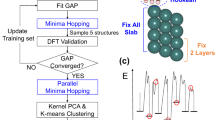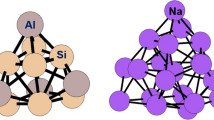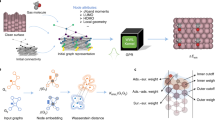Abstract
Adsorbate interactions with substrates (e.g. surfaces and nanoparticles) are fundamental for several technologies, such as functional materials, supramolecular chemistry, and solvent interactions. However, modeling these kinds of systems in silico, such as finding the optimum adsorption geometry and energy, is challenging, due to the huge number of possibilities of assembling the adsorbate on the surface. In the current work, we have developed an artificial intelligence (AI) approach based on an active learning (AL) method for adsorption optimization on the surface of materials. AL uses machine learning (ML) regression algorithms and their uncertainties to make a decision (based on a policy) for the next unexplored structures to be computed, increasing, though, the probability of finding the global minimum with a small number of calculations. The methodology allows an accurate and automated structural elucidation of the adsorbate on the surface, based on the minimization of the total electronic energy. The new AL method for adsorption optimization was developed and implemented in the quantum machine learning software/agent for material design and discovery (QMLMaterial) program and was applied for C60@TiO2 anatase (101). It marks another software extension with a new feature in addition to the automatic structural elucidation of defects in materials and of nanoparticles as well. SCC-DFTB calculations were used to build the complex search surfaces with a reasonably low computational cost. An artificial neural network (NN) was employed in the AL framework evaluated together with two uncertainty quantification methods: K-fold cross-validation and non-parametric bootstrap (BS) resampling. Also, two different acquisition functions for decision-making were used: expected improvement (EI) and the lower confidence bound (LCB).
Graphical abstract











Similar content being viewed by others
Data availability
The datasets generated and analysed during the current study are available from the corresponding author on reasonable request.
Code availability
The QMLMaterial software is available from the corresponding author on reasonable request.
References
Hohenberg P, Kohn W (1964) Inhomogeneous electron gas. Phys Rev 136(3B):B864–B871. https://doi.org/10.1103/PhysRev.136.B864
Koskinen P, Mäkinen V (2009) Density-functional tight-binding for beginners. Comput Mater Sci 47(1):237–253. https://doi.org/10.1016/j.commatsci.2009.07.013
Oliveira AF, Seifert G, Heine T, Duarte HA (2009) Density-functional based tight-binding: an approximate DFT method. J Braz Chem Soc 20:1193–1205
Lourenço MP, dos Santos EC, Pettersson LGM, Duarte HA (2020) Accurate SCC-DFTB parametrization for bulk water. J Chem Theory Comput 16(3):1768–1778. https://doi.org/10.1021/acs.jctc.9b00816
Lookman T, Balachandran PV, Xue D, Yuan R (2019) Active learning in materials science with emphasis on adaptive sampling using uncertainties for targeted design. npj Computational Materials 5. https://doi.org/10.1038/s41524-019-0153-8
Geudtner G, Calaminici P, Carmona-Espíndola J, del Campo JM, Domínguez-Soria VD, Moreno RF, Gamboa GU, Goursot A, Köster AM, Reveles JU, Mineva T, Vásquez-Pérez JM, Vela A, Zúñinga-Gutierrez B, Salahub DR (2012) deMon2k. WIREs Computational Molecular Science 2(4):548–555. https://doi.org/10.1002/wcms.98
Hourahine B, Aradi B, Blum V, Bonafé F, Buccheri A, Camacho C, Cevallos C, Deshaye MY, Dumitrică T, Dominguez A, Ehlert S, Elstner M, van der Heide T, Hermann J, Irle S, Kranz JJ, Köhler C, Kowalczyk T, Kubař T, Lee IS, Lutsker V, Maurer RJ, Min SK, Mitchell I, Negre C, Niehaus TA, Niklasson AMN, Page AJ, Pecchia A, Penazzi G, Persson MP, Řezáč J, Sánchez CG, Sternberg M, Stöhr M, Stuckenberg F, Tkatchenko A, Yu VWz, Frauenheim T, (2020) DFTB+, a software package for efficient approximate density functional theory based atomistic simulations. J Chem Phys 152(12):124101. https://doi.org/10.1063/1.5143190
Lourenço MP, dos Santos AA, Rosa AL, Frauenheim T, da Silva MC (2020) An adaptive design approach for defects distribution modeling in materials from first-principle calculations. J Mol Model 26(7):187. https://doi.org/10.1007/s00894-020-04438-w
Lourenço MP, Galvão BRL, Barrios Herrera L, Hostaš J, Tchagang A, Silva MX, Salahub DR (2021) A new active learning approach for global optimization of atomic clusters. Theoret Chem Acc 140(6):62. https://doi.org/10.1007/s00214-021-02766-5
Lourenço MP, Herrera LB, Hostaš J, Calaminici P, Köster AM, Tchagang A, Salahub DR (2021) Taking the multiplicity inside the loop: active learning for structural and spin multiplicity elucidation of atomic clusters. Theoret Chem Acc 140(8):116. https://doi.org/10.1007/s00214-021-02820-2
Jones DR, Schonlau M, Welch WJ (1998) Efficient global optimization of expensive black-box functions. J Global Optim 13(4):455–492. https://doi.org/10.1023/A:1008306431147
Lai TL, Robbins H (1985) Asymptotically efficient adaptive allocation rules. Adv Appl Math 6(1):4–22. https://doi.org/10.1016/0196-8858(85)90002-8
Deshpande S, Maxson T, Greeley J (2020) Graph theory approach to determine configurations of multidentate and high coverage adsorbates for heterogeneous catalysis. npj Comput Mater 6(1):79. https://doi.org/10.1038/s41524-020-0345-2
Llanio-Trujillo JL, Marques JMC, Pereira FB (2011) An evolutionary algorithm for the global optimization of molecular clusters: application to water, benzene, and benzene cation. J Phys Chem A 115(11):2130–2138. https://doi.org/10.1021/jp1117695
Todorović M, Gutmann MU, Corander J, Rinke P (2019) Bayesian inference of atomistic structure in functional materials. npj Comput Mater 5(1):35. https://doi.org/10.1038/s41524-019-0175-2
Moreno C, Stetsovych O, Shimizu TK, Custance O (2015) Imaging three-dimensional surface objects with submolecular resolution by atomic force microscopy. Nano Lett 15(4):2257–2262. https://doi.org/10.1021/nl504182w
Oh W-C, Zhang F-J, Chen M-L (2010) Synthesis and characterization of V-C60/TiO2 photocatalysts designed for degradation of methylene blue. J Ind Eng Chem 16(2):299–304. https://doi.org/10.1016/j.jiec.2009.09.065
Liu X, Salahub DR (2015) Molybdenum carbide nanocatalysts at work in the in situ environment: a density functional tight-binding and quantum mechanical/molecular mechanical study. J Am Chem Soc 137(12):4249–4259. https://doi.org/10.1021/jacs.5b01494
Lourenço MP, de Oliveira C, Oliveira AF, Guimarães L, Duarte HA (2012) Structural, Electronic, and mechanical properties of single-walled chrysotile nanotube models. J Phys Chem C 116(17):9405–9411. https://doi.org/10.1021/jp301048p
Lourenço MP, Guimarães L, da Silva MC, de Oliveira C, Heine T, Duarte HA (2014) Nanotubes with well-defined structure: single- and double-walled imogolites. J Phys Chem C 118(11):5945–5953. https://doi.org/10.1021/jp411086f
Liu C, Lourenço MP, Hedström S, Cavalca F, Diaz-Morales O, Duarte HA, Nilsson A, Pettersson LGM (2017) Stability and effects of subsurface oxygen in oxide-derived Cu catalyst for CO2 reduction. J Phys Chem C 121(45):25010–25017. https://doi.org/10.1021/acs.jpcc.7b08269
Luschtinetz R, Frenzel J, Milek T, Seifert G (2009) Adsorption of phosphonic acid at the TiO2 anatase (101) and rutile (110) surfaces. J Phys Chem C 113(14):5730–5740. https://doi.org/10.1021/jp8110343
Galvão BRL, Viegas LP, Salahub DR, Lourenço MP (2020) Reliability of semiempirical and DFTB methods for the global optimization of the structures of nanoclusters. J Mol Model 26(11):303. https://doi.org/10.1007/s00894-020-04484-4
Van den Bossche M (2019) DFTB-assisted global structure optimization of 13- and 55-atom late transition metal clusters. J Phys Chem A 123(13):3038–3045. https://doi.org/10.1021/acs.jpca.9b00927
Bisbo MK, Hammer B (2020) Global optimization of atomistic structure enhanced by machine learning. arXiv preprint arXiv:201215222
Efron B The jackknife, the bootstrap and other resampling plans. The Jackknife, the Bootstrap and Other Resampling Plans. https://doi.org/10.1137/1.9781611970319
Kohavi R (1995) A study of cross-validation and bootstrap for accuracy estimation and model selection. Paper presented at the Proceedings of the 14th international joint conference on Artificial intelligence - Volume 2, Montreal, Quebec, Canada,
Mockus J, Tiesis V, Zilinskas A (1978) The application of Bayesian methods for seeking the extremum. In, vol 2. pp 117–129
Shahriari B, Swersky K, Wang Z, Adams RP, Freitas Nd (2016) Taking the human out of the loop: a review of bayesian optimization. Proc IEEE 104(1):148–175. https://doi.org/10.1109/JPROC.2015.2494218
Jørgensen MS, Larsen UF, Jacobsen KW, Hammer B (2018) Exploration versus exploitation in global atomistic structure optimization. J Phys Chem A 122.https://doi.org/10.1021/acs.jpca.8b00160
Rossum GV, Drake FL (2009) Python 3 Reference Manual. CreateSpace,
Pedregosa F, Varoquaux G, Gramfort A, Michel V, Thirion B, Grisel O, Blondel M, Prettenhofer P, Weiss R, Dubourg V, Vanderplas J, Passos A, Cournapeau D, Brucher M, Perrot M, Duchesnay E, Louppe G (2012) Scikit-learn: machine learning in python. Journal of Machine Learning Research 12
Pedregosa F, Varoquaux G, Gramfort A, Michel V, Thirion B, Grisel O, Blondel M, Prettenhofer P, Weiss R, Dubourg V, Vanderplas J, Passos A, Cournapeau D, Brucher M, Perrot M, Duchesnay D (2011) Scikit-learn: machine learning in python. J Mach Learn Res 12:2825–2830
Hunter JD (2007) Matplotlib: A 2D Graphics environment. Comput Sci Eng 9(3):90–95. https://doi.org/10.1109/MCSE.2007.55
Harris CR, Millman KJ, van der Walt SJ, Gommers R, Virtanen P, Cournapeau D, Wieser E, Taylor J, Berg S, Smith NJ, Kern R, Picus M, Hoyer S, van Kerkwijk MH, Brett M, Haldane A, del Río JF, Wiebe M, Peterson P, Gérard-Marchant P, Sheppard K, Reddy T, Weckesser W, Abbasi H, Gohlke C, Oliphant TE (2020) Array programming with NumPy. Nature 585(7825):357–362. https://doi.org/10.1038/s41586-020-2649-2
Virtanen P, Gommers R, Oliphant TE, Haberland M, Reddy T, Cournapeau D, Burovski E, Peterson P, Weckesser W, Bright J, van der Walt SJ, Brett M, Wilson J, Millman KJ, Mayorov N, Nelson ARJ, Jones E, Kern R, Larson E, Carey CJ, Polat İ, Feng Y, Moore EW, VanderPlas J, Laxalde D, Perktold J, Cimrman R, Henriksen I, Quintero EA, Harris CR, Archibald AM, Ribeiro AH, Pedregosa F, van Mulbregt P, Vijaykumar A, Bardelli AP, Rothberg A, Hilboll A, Kloeckner A, Scopatz A, Lee A, Rokem A, Woods CN, Fulton C, Masson C, Häggström C, Fitzgerald C, Nicholson DA, Hagen DR, Pasechnik DV, Olivetti E, Martin E, Wieser E, Silva F, Lenders F, Wilhelm F, Young G, Price GA, Ingold G-L, Allen GE, Lee GR, Audren H, Probst I, Dietrich JP, Silterra J, Webber JT, Slavič J, Nothman J, Buchner J, Kulick J, Schönberger JL, de Miranda Cardoso JV, Reimer J, Harrington J, Rodríguez JLC, Nunez-Iglesias J, Kuczynski J, Tritz K, Thoma M, Newville M, Kümmerer M, Bolingbroke M, Tartre M, Pak M, Smith NJ, Nowaczyk N, Shebanov N, Pavlyk O, Brodtkorb PA, Lee P, McGibbon RT, Feldbauer R, Lewis S, Tygier S, Sievert S, Vigna S, Peterson S, More S, Pudlik T, Oshima T, Pingel TJ, Robitaille TP, Spura T, Jones TR, Cera T, Leslie T, Zito T, Krauss T, Upadhyay U, Halchenko YO, Vázquez-Baeza Y, SciPy C (2020) SciPy 10: fundamental algorithms for scientific computing in Python. Nat Methods 17(3):261–272. https://doi.org/10.1038/s41592-019-0686-2
Grimme S, Antony J, Ehrlich S, Krieg H (2010) A consistent and accurate ab initio parametrization of density functional dispersion correction (DFT-D) for the 94 elements H-Pu. J Chem Phys 132(15):154104. https://doi.org/10.1063/1.3382344
Acknowledgements
We acknowledge the Computational resources provided by the Centro Nacional de Processamento de Alto Desempenho em São Paulo (CENAPAD-SP). We are grateful to Compute Canada/WestGrid for computational resources. Work supported by the National Research Council of Canada, Artificial Intelligence for Design program and by the Natural Sciences and Engineering Research Council of Canada, Discovery Grant (RGPIN-2019-03976).
Funding
This work was supported by the Brazilian agencies: Fundação de Amparo à Pesquisa do Espírito Santo (FAPES) – project CNPq/FAPES PPP 22/2018, Conselho Nacional para o Desenvolvimento Científico e Tecnológico (CNPq), and Coordenação de Aperfeiçoamento de Pessoal de Ensino Superior (CAPES). AMK received funding from CONACYT through the project A1-S-11929.
Author information
Authors and Affiliations
Corresponding author
Ethics declarations
Competing interests
The authors declare no competing interests.
Additional information
Publisher's note
Springer Nature remains neutral with regard to jurisdictional claims in published maps and institutional affiliations.
This paper belongs to Topical Collection XXI—Brazilian Symposium of Theoretical Chemistry (SBQT2021).
Supplementary Information
Below is the link to the electronic supplementary material.
Rights and permissions
About this article
Cite this article
Lourenço, M.P., Herrera, L.B., Hostaš, J. et al. A new active learning approach for adsorbate–substrate structural elucidation in silico. J Mol Model 28, 178 (2022). https://doi.org/10.1007/s00894-022-05173-0
Received:
Accepted:
Published:
DOI: https://doi.org/10.1007/s00894-022-05173-0




